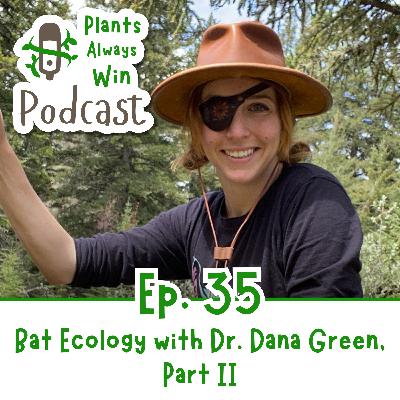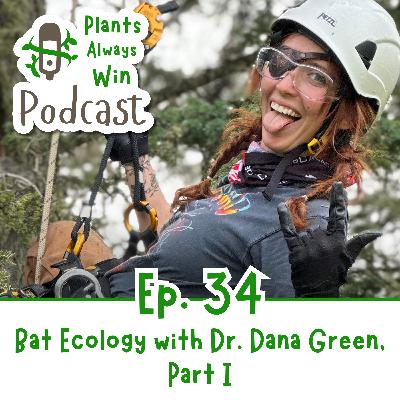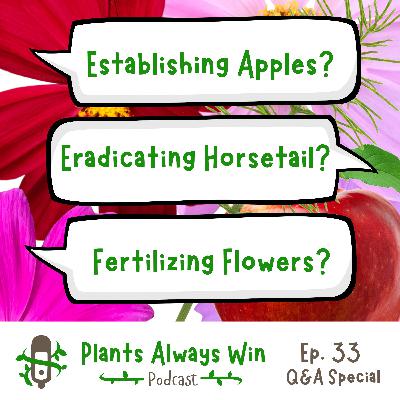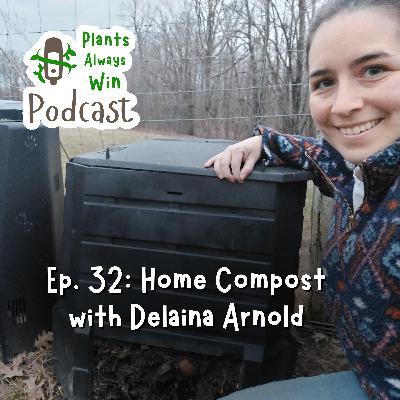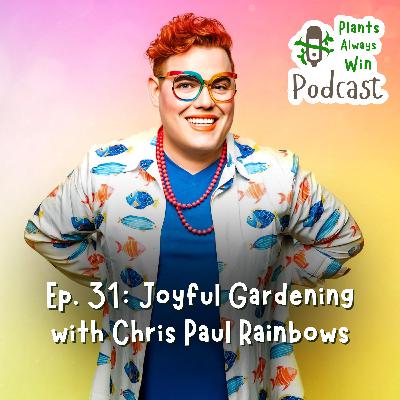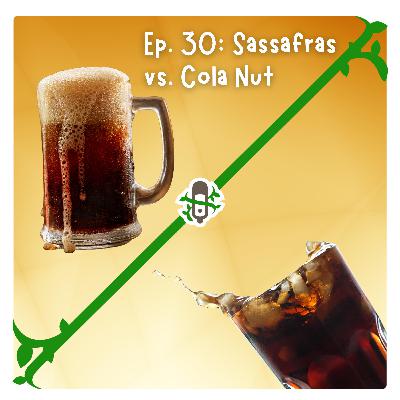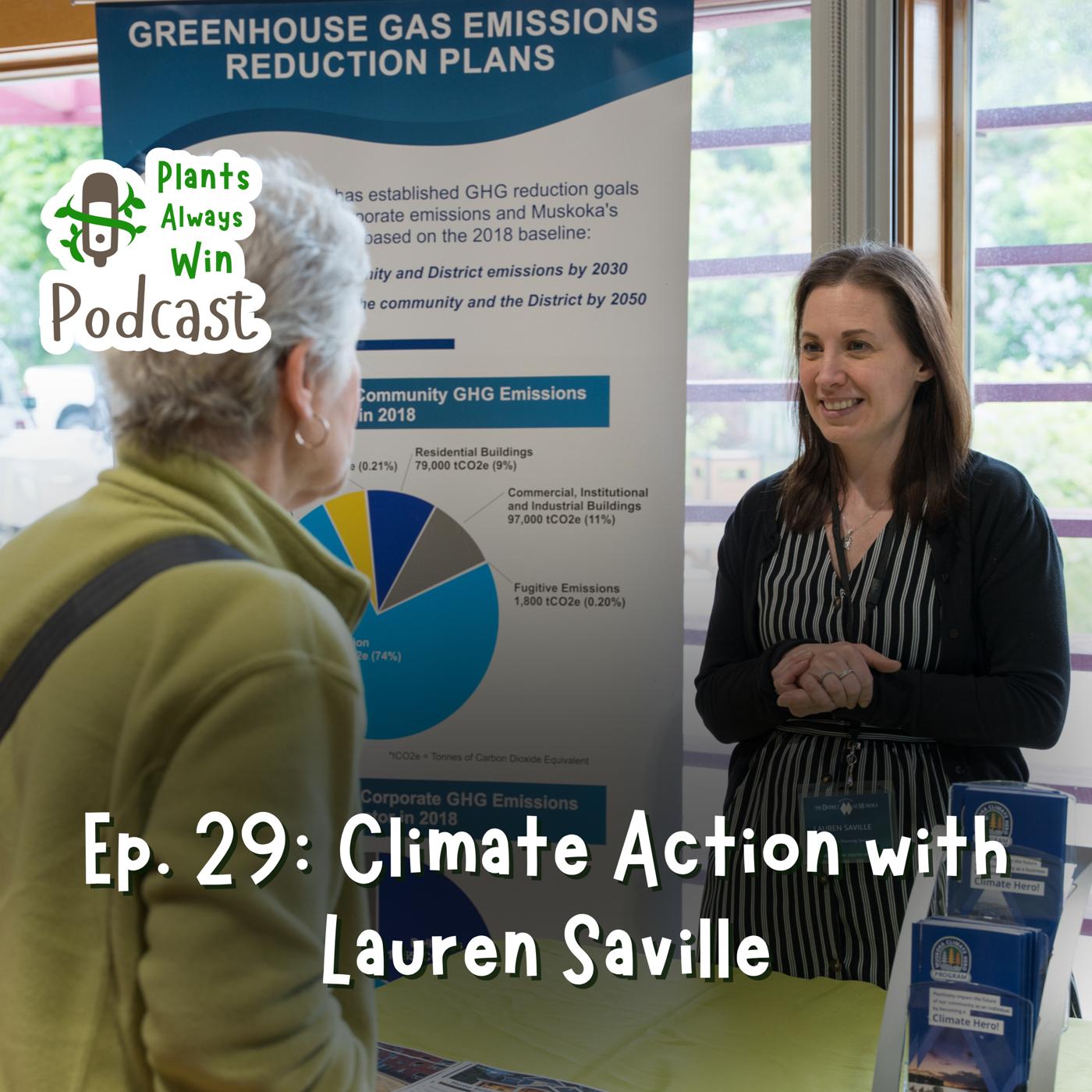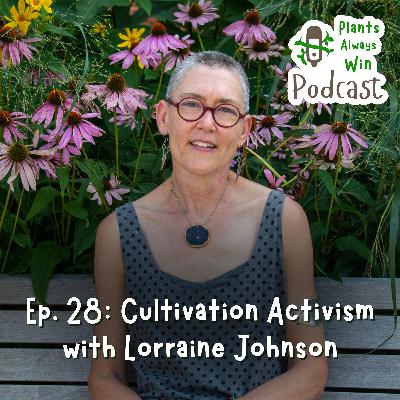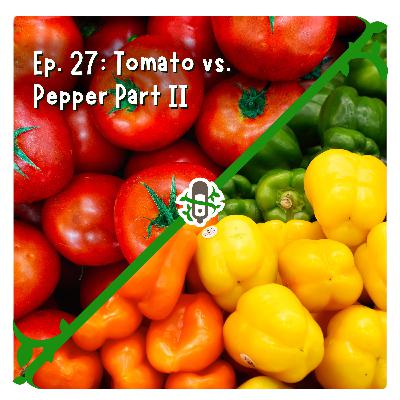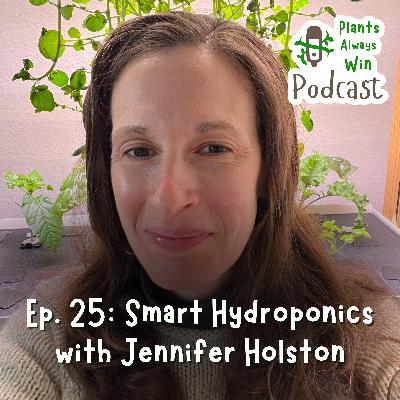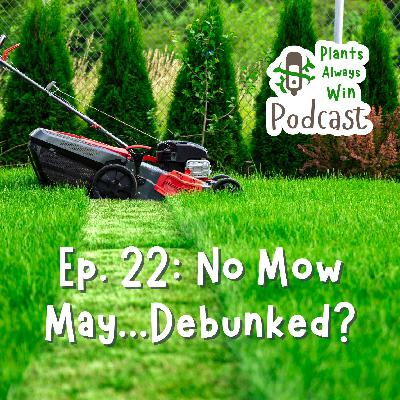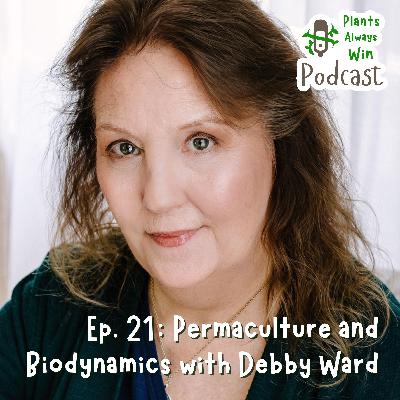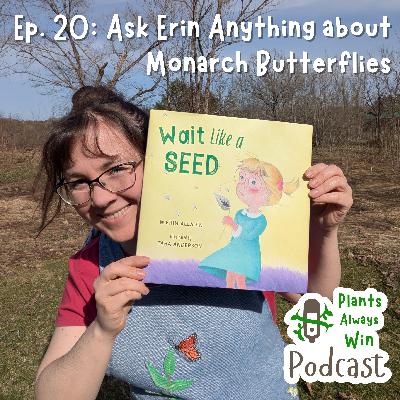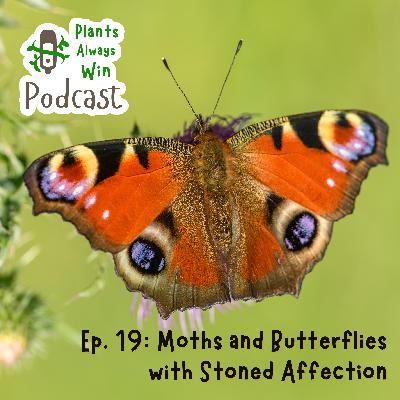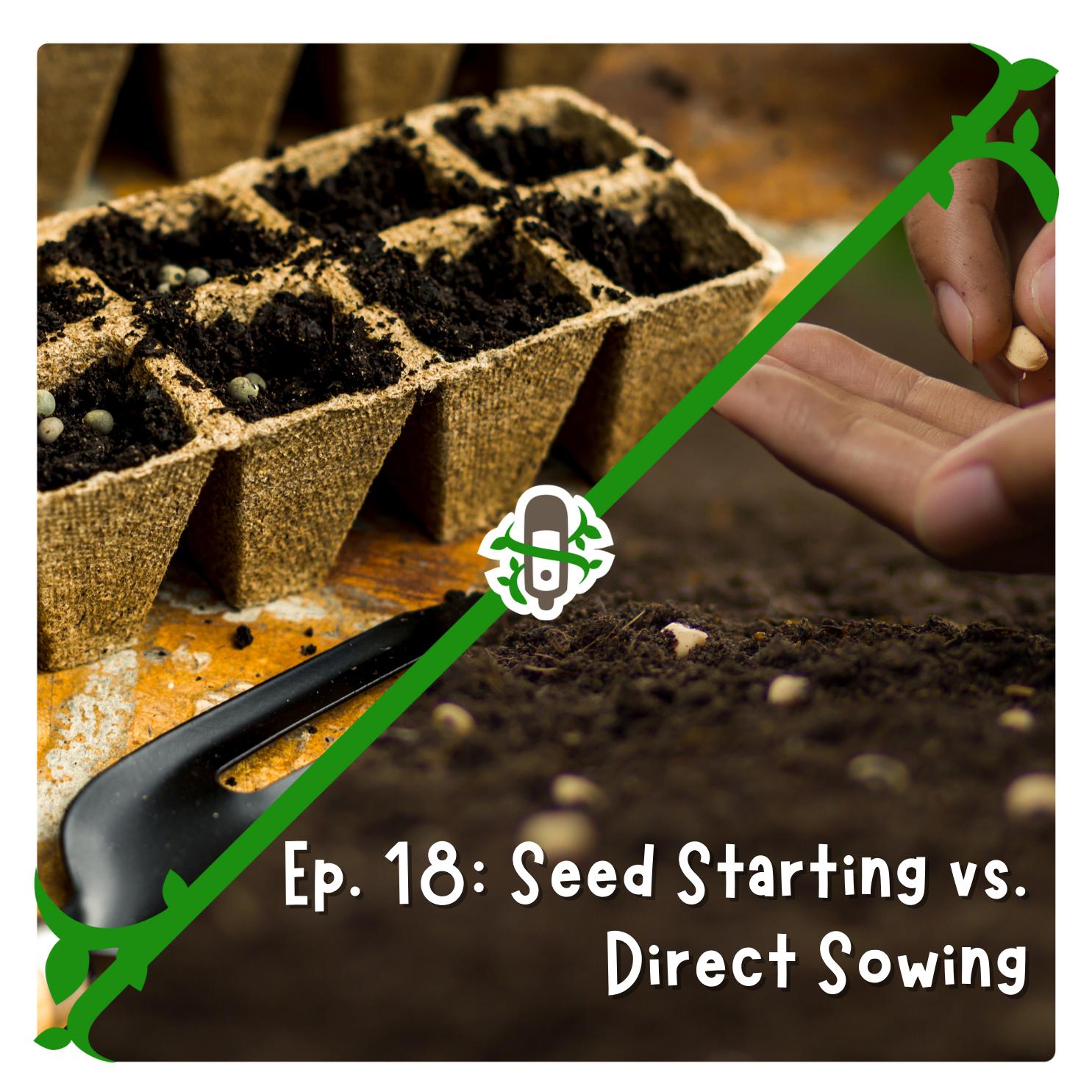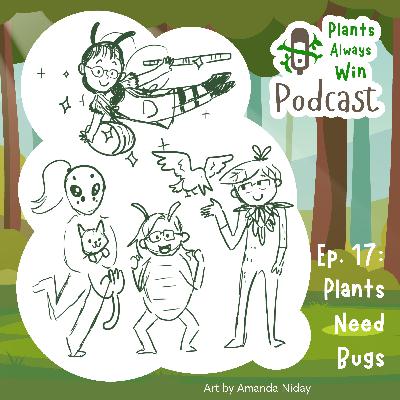Discover Plants Always Win
Plants Always Win

Plants Always Win
Author: Sean Patchett and Erin Alladin
Subscribed: 9Played: 280Subscribe
Share
© Copyright 2025 Plants Always Win
Description
Plants Always Win is a podcast where two Ontario gardeners dive down plant-fact rabbit-holes, answer audience questions, interview intriguing guests, and compete to bring you the most interesting stories and information. We care about ecologically sound gardening, strong human communities, and up-to-date science.
36 Episodes
Reverse
This episode is for anyone who has ever daydreamed about starting a community garden and for anyone who needs the boost of a good-news gardening story. Our guest is Jessica Letteer, who founded the Wilkes-Barre Area Community Gardens five years ago and kicked off a local movement of soil building and community gardening in an area marked by poverty, blighted soil, and food deserts. Jess’ home in Pennsylvania’s Wyoming Valley bears the contamination left behind by abandoned coal mines, and services and infrastructure are chronically under-resourced. But she and a small group of other volunteers reached out to their city council, solicited donations, and started a program that now grows and distributes food, teaches regenerative agriculture skills, and puts on community events—all for free. Longtime listeners will know that our co-host Erin Alladin also founded a community garden: Garden@Kimbourne Community Permaculture Project in Toronto, Ontario. In this episode, she and Jess compare notes on the steps they each took to start their projects and how they and their fellow volunteers kept them going. Jess also tells us about the process of establishing a nonprofit, about the other community organizations her group has partnered with, the ways they're funding the garden, and—of course—all the incredible projects they have lined up for the future.Learn More:The Wilkes-Barre Area Community Gardens Facebook Page: https://www.facebook.com/groups/wilkesbarreacg/Organizations Named in this EpisodeEastern Pennsylvania Coalition for Abandoned Mine Reclamation: https://epcamr.org/home/ Food Dignity: https://fooddignitymovement.org/ Rising Tide Wellness: https://risingtide-wellness.org/ WIC: https://www.fns.usda.gov/wic The Horti AwardsVote for Wait Like a Seed here! Scroll to the very bottom and select it from the Books drop-down menu. You don’t have to vote in every category.Comments? Feedback? Want your garden question to be featured in a future Q&A segment? Email us, reach out over social media, or get Q&A priority by supporting us on Patreon.Bluesky: @plantsalwayswin.comTikTok: @plantsalwayswinpodcastYouTube: @PlantsAlwaysWinPodcastWebsite: www.plantsalwayswin.comDiscord: https://discord.gg/K6wF9dY4JaTimestamps00:14 Introduction to Jessica Letteer02:12 Introduction to Wilkes-Barre Area Community Gardens03:35 How Wilkes-Barre Area Community Gardens Got Their Start08:19 How Garden@Kimbourne Got its Start09:58 Water Break: Wait Like a Seed and the Horti Awards10:33 Concerns about Crime and Community Gardens12:67 Healing the Community through Gardening13:55 Becoming a Nonprofit15:01 Partnering with Other Organizations17:50 Food Dignity: Paying Farmers, Feeding People for Free19:55 More Energy and Infrastructure Projects in the Gardens21:55 Why Is Running All This With You???25:36 Funding!26:44 Gardening in a Former Coal Town32:27 Creating an Accessible Garden for People with Disabilities35:15 What's Next for Wilkes-Barre Community Gardens36:18 Find The Garden Community Online37:00 Shout-Outs38:58 Outro and Contact Us
Dr. Dana Green, a.k.a. "The Eyepatch Biologist" is back for part two! This free-flying conversation just couldn't be contained to a single hour.We plunge straight in this week with an urgent question: how do bats relieve themselves without dribbling on their own heads? From there the facts come thick and fast: microchiroptera (our local insect-eating, echolocating bats) vs. megachiroptera (bigger fruit-eating bats from other climates that don't echolocate); the truth about bats' sense of sight; and the unexpected songs of silverhair bats. Dana shares how to attract bats to our properties without welcoming them into our homes, and we delve into the devastating consequences of pesticide use in the ecosystem—and how to report it when you witness someone applying pesticides illegally. Throughout the interview we also get some of Dana's opinions on the quality of bat representation in media, including Daredevil, Dungeons and Dragons, Batman and vampire books. The episode wraps up with a lightning round of facts, favourites, and myth busting—and a promise to bring Dana back for even more ecological eloquence in the future!Learn More:Dana's website: https://www.danagreeneco.com/TikTok: https://www.tiktok.com/@theeyepatchbiologistInstagram: https://www.instagram.com/eyepatchbiologist/Comments? Feedback? Want your garden question to be featured in a future Q&A segment? Email us, reach out over social media, or get Q&A priority by supporting us on Patreon.Bluesky: @plantsalwayswin.comTikTok: @plantsalwayswinpodcast YouTube: @PlantsAlwaysWinPodcastWebsite: www.plantsalwayswin.comDiscord: https://discord.gg/K6wF9dY4JaTimestamps00:12 Introduction01:00 How do Bats Relieve Themselves?01:58 Flying Foxes, or Megachiroptera, a Subgroup of Bats03:30 Bats Aren't Blind04:48 Echolocation Representation in Daredevil06:00 Bats that Jam Each Other's Echolocation Signals07:28 Singing Silverhair Bats10:25 Creating Bat Habitat at Your Home12:00 Pesticides in the Ecosystem20:15 Lightning Round20:28 Should We Be Concerned about Diseases in Bats?20:46 Are Bats Attracted to Long Hair?21:17 Do Bats Suck Blood? Should We Worry?23:03 Do Bats Mate for Life? What's a Bat Leck?23:48 Hammerhead Bats' Big Honkers24:40 The World's Biggest Bat26:00 The World's Smallest Bat28:39 Cutest Bat Struggles29:40 The World's Ugliest (and Wrinkliest) Bat31:00 A Bat Scientist's Opinion on Batman34:20 Great Bat Representation in Kids' Books and Movies36:00 Dana's Love of Vampires39:15 Find Dana Online41:44 Outro and Contact Us
Dr. Dana Green is a bat expert who is known online as The Eyepatch Biologist. As a science communicator, a pun connoisseur, and a woman who knows a good joke when it's staring her in the face, she says of herself, "What a wonderful bat advocate to go half blind."In Dana's interview with Sean, she tells us about her master's degree studying grasshopper mice (predatory, solitary, highly aggressive mice that howl) and her PhD in bat ecology, which she completed at the University of Regina in Saskatchewan. We learn about echolocation and other bat chatter, fact check Hank Green's viral video (Do we know where bats go in winter? Not entirely...) and learn about bat species in Canada. We assuage some fears about bats carrying disease, explore the challenges of tracking bat migration, exclaim over the mysteries of bat reproduction, and celebrate their benefits in the garden. The episode is as wide-ranging as these fascinating mammals are, but we spend time especially on the lives of hoary bats, pallid bats, New Zealand's flightless bats, and the Mexican free-tailed bat...or at least their smell! Craving even more bat facts? Then you're in luck! Part two of this interview will be posted next week. Learn MoreDana's website: https://www.danagreeneco.com/TikTok: https://www.tiktok.com/@theeyepatchbiologistInstagram: https://www.instagram.com/eyepatchbiologist/Scientists and CommunicatorsSean and Dana drop a lot of names in this conversation. Here are the experts they mention: Hank Green, science communicator: https://hankgreen.com/ Dr. Brock Fenton, bat researcher and mentor of bat researchers: https://letstalkscience.ca/careers/brock-fentonMark Brigham, Dana's supervisor at the University of Regina: https://www.uregina.ca/science/biology/directory/academic-staff-and-adjuncts/mark-brigham.html Robert Barclay, bat researcher: https://profiles.ucalgary.ca/robert-barclay Ted Weller, migratory hoary bat researcher: https://www.researchgate.net/profile/Theodore-Weller Sophiane, aka @honkifurhoary, science communicator: https://www.instagram.com/honkifurhoary/Comments? Feedback? Want your garden question to be featured in a future Q&A segment?Email us, reach out over social media, or get Q&A priority by supporting us on Patreon.Bluesky: @plantsalwayswin.comTikTok: @plantsalwayswinpodcastYouTube: @PlantsAlwaysWinPodcastWebsite: www.plantsalwayswin.comDiscord: https://discord.gg/K6wF9dY4JaCitationsBat Reproduction Fact CheckH, T. (2020, October 16). BAT Reproduction – Illinois BAT Conservation program. https://www.illinoisbats.org/bat-reproduction Timestamps00:12 Introducing Dr. Dana Green01:36 Bats, Grasshopper Mice, and Going Feral: Dana's Education Journey04:55 Sound Bite: Grasshopper Mouse05:01 Can You Hear Echolocation? 05:30 Sound Bite: Echolocation07:25 Dana's Retinal Detachment15:40 Dana Caused Sean's First TikTok Violation16:53 Bat Species in Canada19:00 The Bat Research Community21:30 Do We Know Where Bats Go In Winter?25:53 Bats' Unique Relationship with Disease28:47 Tangent: Funding Rant31:00 Back to Bat Tracking34:45 Ted Weller, Bat Pregnancy, and Pups41:36 The Pallid Bat, Potential Pollinator and Centipede Eater44:00 Bats as Garden Friends47:33 Outdoor Cats are Ecological Disasters51:42 Bats' Horrendous Smell53:46 Conclusion and Contact Us
Our gardens are winding down for the season, but our audience is putting on a growth spurt! This crop of new listeners has seeded our Q&A inbox with a flush of questions, which we love to see. And while we’d normally answer these at the end of our versus episodes, we currently have a backlog of recorded episodes and we don’t want folks to have to wait for answers. That means it’s time for another Q&A special!We start with questions inspired by Sean’s recent video about an apple tree sold with its graft and root flare buried well below soil level. If you want to understand how fruit trees are grafted and sold, how to plant them successfully, and what to expect from them as they grow, keep your ears peeled for this conversation.Next, we move on to plants that listeners are hoping to get rid of, touching briefly on bindweed (covered more thoroughly in episode 31) before digging into horsetail, that pervasive prehistoric plant. The question was “How do I get rid of it?” and we do address that—but you’ll find some options you might not have expected in our answers.Finally, we chat about an anecdote that was shared with us: “This year I learned that cosmos don’t like fertilizer.” It’s true that feeding nitrogen to flowering plants will push them to produce more greenery than blooms. But we’re here to offer some education on what you can do to give them a boost.Comments? Feedback? Want your garden question to be featured in a future Q&A segment? Email us, reach out over social media, or get Q&A priority by supporting us on Patreon. Discord: https://discord.gg/K6wF9dY4Ja Bluesky: @plantsalwayswin.com TikTok: @plantsalwayswinpodcast YouTube: @plantsalwayswinpodcastWebsite: www.plantsalwayswin.com Learn MoreAbout Horsetail: https://www.rhs.org.uk/weeds/horsetailFind bare-root fruit trees grown in Ontario from:Golden Bough Tree Farm (Marlbank, ON, in Tweed): https://goldenboughtreefarm.ca/ Northern Food Forest (Calvin, ON, near North Bay): https://northernfoodforest.ca/ Pineneedle Farms (Pontypool, ON, within Kawartha Lakes: https://www.pineneedlefarms.ca/ Silver Creek Nursery (Wellesley, Ontario, in the Waterloo region): https://silvercreeknursery.ca/Whiffletree Farm & Nursery (Elora, ON): https://www.whiffletreefarmandnursery.ca/ CreditsWebsite Design and Illustration by Sophia AlladinIntro and Outro Music from #Uppbeat (free for Creators!): https://uppbeat.io/t/soundroll/when-my-ukulele-playsLicense code: GWOIMMBAS15FG6PHTimestamps00:12 Intro00:55 What’s Growing On? Erin's Fall Fair Entries04:46 What's Growing On? Sean's Fall Fruit Trees Planting08:50 Water Break10:42 Is a buried graft the reason my apple tree keeps dying?11:43 What is a root flare? 14:54 Do nurseries make mistakes like this on purpose to sell more trees?16:36 Will a tree always die if its graft is below ground level?19:07 If you let suckers from a root stock grow up, will they produce fruit?21:40 If the tree survives having its graft buried, is everything okay?23:00 I planted apples 3-4 years ago. They are suckering like crazy and haven’t produced any fruit. What can I do?25:45 What fruit tree is best to plant in Ontario - something hardy and not fussy?30:15 What if I need to eradicate field bindweed from my lawn instead of my garden?35:42 How can I get rid of horsetail? I tried replacing all my soil and it still came back.45:01 Fertilizing stopped my flowers from blooming. What should I have done?56:00 Outro and Contact Us
Do you make compost at home? Do you delight in the experience? If your answer to either of those questions is no, this week’s guest is here to help.Delaina Arnold is the community programs manager with the Georgian Bay Mnidoo Gamii Biosphere, a UNESCO-designated “ecologically significant” landscape where people are striving to live in balance with nature. As part of that striving, the Biosphere launched a pilot project in 2025 to help people learn about home composting, to get started doing it themselves, and to troubleshoot any problems. Now we get to benefit from all that education, as Delaina answers Erin’s questions on the subject.We begin with the big question: why bother rotting our kitchen scraps at all? Then it’s on to busting common myths before entering a crash course on home composting: where to place your bin, what type to make or buy, and how not to hate the container you use for collecting scraps. We troubleshoot common problems like wildlife, smell, and slow decomposition, then get into a tangent on the truth about using urine in your compost. Of course we also cover how to decompose your garden trimmings safely and what to do with manure. Ready to make some black gold with us? Then dive in to the interview.Learn More“Do the Rot Thing” webinar: https://www.youtube.com/watch?v=74UODcc3IZEAll the Biosphere’s short, downloadable gardening guides, including “Composting 101”: https://georgianbaybiosphere.com/gardens/The Biosphere’s community calendar: https://georgianbaybiosphere.com/events/ The Georgian Bay Biosphere Reserve website: https://georgianbaybiosphere.com/CitationsUrine and Soil StudyRumeau, M., Pistocchi, C., Ait-Mouheb, N., Marsden, C., & Brunel, B. (2024). Unveiling the impact of human urine fertilization on soil bacterial communities: A path toward sustainable fertilization. Applied Soil Ecology, 201, 105471. https://doi.org/10.1016/j.apsoil.2024.105471Follow the Biosphere On Social MediaOn Facebook: https://www.facebook.com/gbtownship/ On YouTube: https://www.youtube.com/@GBayBiosphere Comments? Feedback? Want your garden question to be featured in a future Q&A segment? Email us, reach out over social media, or get Q&A priority by supporting us on Patreon. Discord: https://discord.gg/K6wF9dY4Ja Bluesky: @plantsalwayswin.com TikTok: @plantsalwayswinpodcast YouTube: @plantsalwayswinpodcastWebsite: www.plantsalwayswin.com CreditsWebsite Design and Illustration by Sophia AlladinIntro and Outro Music from #Uppbeat (free for Creators!): https://uppbeat.io/t/soundroll/when-my-ukulele-playsLicense code: GWOIMMBAS15FG6PHTimestamps00:12 Intro00:47 Meet Delaina Arnold of the Georgian Bay Biosphere01:50 What is the Georgian Bay Biosphere Reserve?05:08 Why Home Composting Matters: Landfills, Methane, and Soil09:09 The Seguin & Township of Georgian Bay Kitchen to Compost Pilot Project11:33 Myths about Home Composting: Wildlife, Stirring, and What to Add14:47 What if You Don't Turn Your Compost? Erin's Dirty, Little Secret16:35 Where to Locate Your Compost Bin: Sun, Drainage, and Access18:14 Choosing Your Compost Bin20:09 Pick a Cute Countertop Compost Container22:30 Composting Tips23:27 Composting Troubleshooting25:15 Wildlife Problems with Compost29:19 Fact Check: Adding Urine to Compost32:20 Brown Materials You Can Add34:05 Can You Add Garden Clippings to Your Compost Bin? 37:45 Resources and Contact for the Georgian Bay Biosphere39:30 Outro and Contact Us
“I am very enthusiastic about [gardening]. I don't know if I'm that great at it. I'm not very knowledgeable. I can't really answer any of your garden questions, but I love getting my hands dirty.”Gardening is for everyone! We’ve interviewed plenty of experts on Plants Always Win who’ve mastered everything from groundcovers to home hydroponics, but every so often we like to bring you a less experienced guest who is already skilled in one crucial area: gardening with joyful abandon.In their day job, Chris Paul Rainbows is a speaker and strategist who helps organizations create spaces where everyone belongs. In their own space at home, Chris has tapped into the joy that 80s and 90s children’s television once brought them, designing whimsical gardens inspired by Polkadot Door, Mr. Dressup, Sesame Street, and more. They take us back to the urban-farm inspiration that led them to buy their current home, and the transformation it has undergone with chickens, rabbits, and a surprise pumpkin patch that led to some heartwarming community building. Community, gardening, and cultivating joy are inextricable subjects for Chris, who is an activist for queer and trans visibility. We talk hostas, native plants, managing invasive bindweed, and Chris’ upcoming debut book for 2026, Guinea Pigs Don’t Wear Pants. Now come on into the pumpkin patch through the Polkadot Door and remind yourself just how FUN gardening can be. Find Chris Paul Rainbows Onlineat their website, where you can also find information about Chris’ upcoming picture book, Guinea Pigs Don’t Wear Pants: https://www.chrispaulrainbows.com/ on TikTok: tiktok.com/@chrispaulrainbowson Instagram: instagram.com/chrispaulrainbows/on YouTube: youtube.com/@chrispaulrainbows on Facebook: facebook.com/Chrispaulrainbows/on LinkedIn: linkedin.com/in/chrisfarias/ Learn More About The Unicorn Fund: https://www.chrispaulrainbows.com/blog/unchained-philanthropy-hamiltonComments? Feedback? Want your garden question to be featured in a future Q&A segment? Email us, reach out over social media, or get Q&A priority by supporting us on Patreon. Discord: https://discord.gg/K6wF9dY4Ja Bluesky: @plantsalwayswin.com TikTok: @plantsalwayswinpodcast YouTube: @plantsalwayswinpodcastWebsite: www.plantsalwayswin.com CreditsWebsite Design and Illustration by Sophia AlladinIntro and Outro Music from #Uppbeat (free for Creators!): https://uppbeat.io/t/soundroll/when-my-ukulele-playsLicense code: GWOIMMBAS15FG6PHTimestamps00:25 Introduction and Housekeeping01:55 Meet Chris Paul Rainbows03:10 Gardening as Play06:29 Protesting for Urban Chickens07:47 Female and Male Gingko Biloba Trees09:35 Corpse Flowers and Little Shop of Horrors11:30 Pest Control and Fertilizer: Chickens Will Provide13:45 Can You Go to Jail for an Overgrown Lawn?15:17 Invasive Micro-Clover Lawn Replacement16:29 Militant Native Plant Communities17:23 Chris' Inner Child Garden Project19:47 300 Accidental Pumpkin Plants21:54 The Unicorn Fund and the Most Sincere Pumpkin Patch24:14 Pumpkin Care and Powdery Mildew27:30 Strange and Fun Pumpkin Types29:15 Hand Pollinating Pumpkins30:30 The Importance of Queer and Trans Joy33:50 Plant Sexes and Pollination37:15 Chris and Sean Talk Parrots and Budgies41:03 Dealing with Field Bindweed47:27 Chris' Children's TV-inspired Garden Plans48:39 Relationship Roles: The Problem Maker and the Problem Solver49:36 How Oscar the Boxwood Grouch Started Everything52:09 Find Chris Online52:46 Chris' Upcoming Picture Book, Guinea Pigs Don't Wear Pants53:56 Outro and Contact Us
Are you finding yourself thirsty for a little soda pop this summer? How about for some botanical knowledge about soda pop’s history?In this plant face-off episode, Erin and Sean put some fizz into the competition with the plants behind two iconic flavours: the cola nut that gives cola its kick, and the sassafras that puts the root in root beer. Or, at least, the plants that did serve those roles before the advent of artificial flavouring. Erin takes the first swig with a dramatic overview of the North American Sassafras albidum, an aromatic tree with a long history of use for medicine, food, furniture, and one nautical beverage that almost saw it hunted to extinction. She peers into the muddy waters surrounding its first use in root beer and, later, its controversial ban by the FDA, speculates about Choctaw influence on its use in gumbo, and delights over the Kanien’kéha (Mohawk) name, wenhákeras, meaning “smelly thing.” Sean takes his kick at the can with the cola nut, the key ingredient behind the flavour and caffeine of cola beverages. He discusses the flavourful Malvaceae family tree of the West African cola tree (also spelled kola) (Cola nitida and Cola acuminata) and its surprising identity as a broad-leaf evergreen before serving up some knowledge about the fruit’s growing habits and its cultural history as a stimulant and a beverage ingredient. After some medical meanderings and a look at modern-day distribution, we wrap up Coca-Cola origins and its present-day ingredients.Who had the most interesting facts to share today? Vote for your favourite by tagging us on social media and using the hashtag #PAWFaceOff. Comments? Feedback? Want your garden question to be featured in a future Q&A segment? Email us, reach out over social media, or get Q&A priority by supporting us on Patreon. Discord: https://discord.gg/K6wF9dY4Ja Bluesky: @plantsalwayswin.com TikTok: @plantsalwayswinpodcast YouTube: @plantsalwayswinpodcastWebsite: www.plantsalwayswin.com CreditsWebsite Design and Illustration by Sophia AlladinIntro and Outro Music from #Uppbeat (free for Creators!): https://uppbeat.io/t/soundroll/when-my-ukulele-playsLicense code: GWOIMMBAS15FG6PHCitationsCommon names for sassafrasWood and charcoal indentification in southern MD. (n.d.). https://apps.jefpat.maryland.gov/woodandcharcoalid/Webpages-trees/Sassafras.htmIndigenous names for sassafrasPlenty Canada. (2024). SaSSaFras. Greenbelt Indigenous Botanical Survey. https://gibsurvey.ca/species/sassafrasFurniture usesPackard Forest Products. (2011, October 30). Sassafras - Packard Forest products. https://packardforestproducts.com/lumber/hardwood-lumber/species-guide/sassafras/Food and medicine usesMacKinnon, A., & Kershaw, L. (2016). Edible and medicinal plants of Canada. Publishing Partners.Root beer’s origins and the banning of safrole oilVerberg, S. (2023, November 30). Root beer: the quintessential American soda. American Homebrewers Association. https://homebrewersassociation.org/beyond-beer/root-beer-the-quintessential-american-soda/Sassafras oil and toxicityhttps://www.sciencedirect.com/topics/pharmacology-toxicology-and-pharmaceutical-science/sassafrasThe history of sassafras in North AmericaSassafras: Native gem of North America. (2022, October 10). Cornell Botanic Gardens. https://cornellbotanicgardens.org/sassafras-native-gem-of-north-americaSassafras in OntarioSassafras. (n.d.). ontario.ca. https://www.ontario.ca/page/sassafrasGrowing sassafrasSassafras albidum (Cinnamon Wood, Common Sassafras, Mitten Tree, Sassafras, White Sassafras) | North Carolina Extension Gardener Plant Toolbox. (n.d.). https://plants.ces.ncsu.edu/plants/sassafras-albidum/Hassani, N. (2025, May 7). How to grow and care for sassafras. The Spruce. https://www.thespruce.com/sassafras-tree-plant-profile-5199214Cola nut overviewKola Trees (Genus Cola). (n.d.). iNaturalist. https://www.inaturalist.org/taxa/132989-ColaWikipedia contributors. (2025, July 18). Kola nut. Wikipedia. https://en.wikipedia.org/wiki/Kola_nutCola nut etymologyKola - Etymology, Origin & Meaning. (n.d.). Etymonline. https://www.etymonline.com/word/kolaMedicinal uses for cola nut and caffeineCola nut: health benefits, side effects, uses, dose & precautions. (2021, June 11). RxList. https://www.rxlist.com/supplements/cola_nut.htm#:~:text=Cola%20nut%20is%20used%20for,used%20as%20a%20flavoring%20ingredientTimestamps00:11 Introduction01:13 What's Growing On? Sean's Fruit Shrubs and Willow Wall03:38 What's Growing On? Reciprocity in Erin's Vegetable Garden06:03 The Range of Serviceberry Taste06:51 Water Break: Regionalisms07:19 The Plant Face-Off08:25 Sassafras Albidum, an Aromatic Shrub09:08 The Etymology of Sassafras 11:10 Indigenous Names for Sassafras12:55 The Distinct Look of a Sassafras Tree15:47 Wildlife, Building and Dye Use of Sassafras16:16 Sassafras' Medicinal Properties20:00 Eating Sassafras leaves, stems, and pith21:49 How Sassafras Gave Us Root Beer...And What Went Wrong25:27 The Great Sassafras Hunts for Saloop27:33 The Invention of Root Beer28:50 Making Fermented vs. Carbonated Root Beer30:24 Growing Sassafras for Beauty, Hedges, Specimen Trees, and Remediation36:05 Water Break: Love Your Library37:28 Cola Nut? Kola Nut? Pick Your Spelling.39:54 West African Names for Cola Nut40:58 The Etymology of Cola Nut42:56 The Cola Tree, Both Evergreen and Deciduous43:55 Cola's Unusual Flowering and Fruiting Habit45:45 Cola Range and Cultivation46:44 The Cola Nut: A Fleshy Pod47:57 Culinary and Medicinal Uses of Cola51:00 Cultural and Hospitality Uses in West Africa52:29 Cola Nut Harvesting53:20 The Invention of Coca Cola54:40 1880 Ad for Coca Cola, an "Intellectual Beverage"56:11 Conclusion and Contact Us
This week we’re celebrating the difference that can be made when a regional government supports its people and businesses in taking climate action. Get inspired by impactful local initiatives in Muskoka, Ontario, like:the Climate Hero Program, which awards individuals and businesses Bronze, Silver, and Gold rankings for the climate-friendly actions they take (including planting a pollinator garden!)the Muskoka EnvironHub website packed with resourcesthe Muskoka GeoHub, an online web mapping portal featuring floodplain mapping, real-time water levels, shoreline videos, and morea Community Energy and Emissions Reduction Planand, importantly, a Corporate Greenhouse Gas Initiative since the onus for change cannot be on residents alone.Our guest, Lauren Saville, is the Community Climate Initiatives Coordinator in Muskoka. Her work takes her into the heart of a cottage-country community where “the environment is the economy and the economy is the environment.” She helps residents understand how the changing climate is impacting their wallets and ways of life, and offers them opportunities to make real change. She gives presentations to schools and to the public, inspiring and equipping them to take action in their own lives. And she’s involved with a huge range of initiatives that make life better for people AND the planet. Listen now and get motivated by the interconnectedness of environment, economy, and community well-being. Access Muskoka’s excellent community resources:The Climate Hero Program: https://www.engagemuskoka.ca/climate-heroesThe Muskoka EnviroHub: https://www.muskoka.on.ca/en/environment/EnviroHub.aspxUpcoming Outreach and Education Events with Lauren: https://www.muskoka.on.ca/en/environment/outreach-and-education.aspx The Muskoka GeoHub: https://www.muskoka.on.ca/en/environment/maps.aspx segment? Email us, reach out over social media, or get Q&A priority by supporting us on Patreon. Discord: https://discord.gg/K6wF9dY4Ja Bluesky: @plantsalwayswin.com TikTok: @plantsalwayswinpodcast YouTube: @plantsalwayswinpodcastWebsite: www.plantsalwayswin.com CreditsWebsite Design and Illustration by Sophia AlladinIntro and Outro Music from #Uppbeat (free for Creators!): https://uppbeat.io/t/soundroll/when-my-ukulele-playsLicense code: GWOIMMBAS15FG6PHTimestamps00:50 Introducing Lauren Saville, Community Climate Initiatives Coordinator02:20 Tackling Climate Change at the Community and Corporate Levels06:43 Insurers are Motivated to Mitigate Climate Change07:51 How the Community Responds09:37 Climate Complacency: When Nature's Beauty Backfires11:10 Sean Joins the Climate Hero Program15:04 Lauren's Community and School Talks18:58 Pollinator Plants, Shoreline Greening, and Love Your Lake23:30 Partnering with Other Organizations Drives Change!25:48 What Is a Watershed?27:03 What Lauren Loves About her Job32:15 Love for Muskoka, Love for Nature33:55 Lauren's Home Garden Projects35:15 Find Muskoka's EnviroHub and Stewardship Outreach36:22 We Can All Make Change38:25 Outro and Contact Us
This week we talk about the activism embedded in native plant gardening and the creation of pollinator habitat with Lorraine Johnson.Lorraine styles herself as a “cultivation activist”. It’s a term she came up with to describe the common purpose at the intersection of everything she does, from writing books to giving talks to supporting the fight against harmful grass and weed bylaws. This episode is for anyone who:feels guilt or overwhelm when they think about gardening, native plants, and invasive speciesfeels anger or frustration about garden centres promoting invasive plantsneeds tools and resources to fight bylaws that make it hard to grow ecologically responsible gardens (even in cities that have signed pollinator pledges and are investing in flood protection!)wants to feel re-energized about the value of gardening as activismYou can find Lorraine online at https://lorrainejohnson.ca, where she shares her bibliography, her presentation topics, a blog with lots of updates on native-plant advocacy, and a (sometimes up-to-date) list of upcoming events where she’ll be presenting. Here are the resources Lorraine shared for bylaw advocacy:Network of Nature’s interactive map for finding a native plant nursery near you: https://networkofnature.org/where-to-buy.htm/ Ecological Design Lab’s Bylaws for Biodiversity toolkit for municipalities: https://ecologicaldesignlab.ca/site/uploads/2024/07/EDL_Bylaws-Biodiversity_ToolkitforMunicipalities.pdfThe David Suzuki Foundation Action Alert Bylaw toolhttps://davidsuzuki.org/action/bylaws-for-biodiversity/ The 1000 Islands Master Gardeners’ post about the Kingston, Ontario bylaw reform on which they collaborated: https://1000islandsmastergardeners.ca/2024/07/29/prohibited-plants-in-kingstons-new-bylaw/A news story about Kyla Moore’s advocacy on Thunder Bay, Ontario’s bylaw change: https://www.tbnewswatch.com/local-news/thunder-bay-could-be-a-leader-says-boulevard-garden-advocate-9982234 Comments? Feedback? Want your garden question to be featured in a future Q&A segment? Email us, reach out over social media, or get Q&A priority by supporting us on Patreon. Discord: https://discord.gg/K6wF9dY4Ja Bluesky: @plantsalwayswin.com TikTok: @plantsalwayswinpodcast YouTube: @plantsalwayswinpodcastWebsite: www.plantsalwayswin.com CreditsWebsite Design and Illustration by Sophia AlladinIntro and Outro Music from #Uppbeat (free for Creators!): https://uppbeat.io/t/soundroll/when-my-ukulele-playsLicense code: GWOIMMBAS15FG6PHTImestamps00:11 Introducing Lorraine Johnson01:29 Cultivation Activist: Making Change with Plants07:53 Native-Plant Gardening for Joy, not as a Burden11:16 Tips to get Started with Native Plants12:40 Finding Your Community of Pollinator People15:52 Relieving the Burden: Do the Best You Can17:50 What has Changed in Four Decades of Native-Plant Gardening23:13 Meet People Where they're at25:45 Reclaiming Responsibility as a Joy27:14 Plants as our Kin27:20 Changing Language: Naturalized vs. Native31:44 Changing Language: Invasive Species and Groundcovers34:46 Native Groundcover Options38:00 Gardening Isn't Just for Humans40:00 Reforming Grass and Weeds Bylaws45:00 Convincing Municipalities to Change Bad Bylaws46:00 Kyla Moore's Successful Bylaw Campaign in Thunder Bay, Ontario47:41 Proactive Bylaw Reform in Kingston, Ontario48:48 Native Plant Suggestions for New Developments51:07 Street Trees and Project Swallowtail in Toronto54:01 The Canadian Coalition for Invasive Plant Regulation58:50 "Nothing Will Grow Here." Working with the Land1:05:55 2025: A Year of Abundance1:09:01 Shout-Out: David Suzuki Foundation Action Alert Bylaws1:11:12 Finding Lorraine Online1:14:04 Outro and Contact Us
It’s Part II of the nightshade party!Sean and Erin plunge back in with tomatoes and peppers, covering cultural history, culinary and medical uses, and fun facts about these garden staples of the nightshade family. If you could look back thousands of years to see gardens in the Andes mountains, you would find both of them growing there. Find out how peppers once acted both as a trade good and a discipline tool, where tomatoes have spread most around the world, and the truth about the fantastical-sounding tomato-potato. If you want to know more about growing tomatoes and peppers or to explore their botany and etymology, be sure to check out Part I of this plant face-off. Who brought the most fascinating facts about their plant this week? Vote for borage or cosmos by tagging us on social media and using the hashtag #PAWFaceOff. Comments? Feedback? Want your garden question to be featured in a future Q&A segment? Email us, reach out over social media, or get Q&A priority by supporting us on Patreon. Discord: https://discord.gg/K6wF9dY4Ja Bluesky: @plantsalwayswin.com TikTok: @plantsalwayswinpodcast YouTube: @plantsalwayswinpodcastWebsite: www.plantsalwayswin.com CreditsWebsite Design and Illustration by Sophia AlladinIntro and Outro Music from #Uppbeat (free for Creators!): https://uppbeat.io/t/soundroll/when-my-ukulele-playsLicense code: GWOIMMBAS15FG6PHCitationsThe biggest global tomato-growing nations todaySolanum lycopersicum (Tomato, Tomatoes). (n.d.). North Carolina Extension Gardener Plant Toolbox. https://plants.ces.ncsu.edu/plants/solanum-lycopersicum/#:~:text=The%20genus%20name%2C%20Solanum%2C%20is,when%20they%20came%20to%20EuropeTomato varieties, history, and misconceptions of toxicityThe University of Vermont. (n.d.). A History of Tomatoes. University of Vermont Extension. https://www.uvm.edu/extension/news/history-tomatoes#:~:text=Tomatoes%20have%20undergone%20centuries%20of,Andes%20of%20 western%20South%20africa Heirloom vegetablesHeirloom vegetables. (n.d.). Wisconsin Horticulture. https://hort.extension.wisc.edu/articles/heirloom-vegetables/ Carnivorous tomatoes!Chase, M. W., Christenhusz, M. J. M., Sanders, D., & Fay, M. F. (2009). Murderous plants: Victorian Gothic, Darwin and modern insights into vegetable carnivory. Botanical Journal of the Linnean Society, 161(4), 329–356. https://doi.org/10.1111/j.1095-8339.2009.01014.x Toxicity of capsaicinRohrig, B. (2013). Hot peppers: Muy caliente! In Chemmatters. American Chemical Society. https://www.acs.org/chemmatters The debate about weaponizing capsaicinPeppers as non-lethal weapons. (2022). In The Royal Society of Chemistry eBooks (pp. 145–155). https://doi.org/10.1039/9781839160646-00145Chili peppers in cultural historyKelly, V. a. P. B. C. P. (2021, March 5). The Trail of Fire: The Story of the Chili Pepper. Synaptic Space. https://synapticspace.wordpress.com/2019/05/02/the-long-journey-of-the-chili-pepper/The capsaicin isn’t in the pepper seedsCronin, J. R. (2002). The chili pepper’s pungent principle: capsaicin delivers diverse health benefits. Alternative and Complementary Therapies, 8(2), 110–113. https://doi.org/10.1089/10762800252909865 Timestamps00:11 Introduction01:28 Culinary and Medicinal Uses of Peppers04:30 Pepper Spray Throughout History05:55 Is Capsaicin Toxic? 07:00 Why Capsaicin Burns09:44 Health Benefits of Capsaicin12:24 Nutritional Benefits of Tomatoes16:15 A Brief History of Tomatoes20:41 A Brief History of Peppers27:00 Tomato Fun Facts 30:00 Heirloom Varieties38:43 The Tomato Potato40:36 Tomatoes are Carnivorous?43:22 Pepper Seeds are not Where the Heat Is!44:45 The Scoville Scale to Measure the Heat of Peppers37:37 Outro and Contact Us
In this shady plant face-off, Sean and Erin explore two of the gardening world’s favourite nightshades: tomatoes and peppers. Both are members of the family Solanaceae, and have plenty of traits in common, so rather than splitting the episode in half our two hosts try a livelier approach this week, passing the stage back and forth to talk about their chosen plant’s botany, etymology, growing habits, and pest and disease management. Prepare for a wealth of interesting information (did you know the Spanish word for tomato references an old belief in their aphrodisiac qualities?) alongside practical gardening tips (make sure you don’t feed your pepper plant too late in the season). And what about our other usual categories of cultural history, culinary and medical uses, and fascinating facts? Well, there’s just so much to say about these delicious horticultural staples that you’ll have to tune in next week to hear the rest. Comments? Feedback? Want your garden question to be featured in a future Q&A segment? Email us, reach out over social media, or get Q&A priority by supporting us on Patreon. Discord: https://discord.gg/K6wF9dY4Ja Bluesky: @plantsalwayswin.com TikTok: @plantsalwayswinpodcast YouTube: @plantsalwayswinpodcastWebsite: www.plantsalwayswin.com CreditsWebsite Design and Illustration by Sophia AlladinIntro and Outro Music from #Uppbeat (free for Creators!): https://uppbeat.io/t/soundroll/when-my-ukulele-playsLicense code: GWOIMMBAS15FG6PHCitationsTomato overview and etymologySolanum lycopersicum (Tomato, Tomatoes). (n.d.). North Carolina Extension Gardener Plant Toolbox. https://plants.ces.ncsu.edu/plants/solanum-lycopersicum/#:~:text=The%20genus%20name%2C%20Solanum%2C%20is,when%20they%20came%20to%20EuropeA History of TomatoesThe University of Vermont. (n.d.). A History of Tomatoes. University of Vermont Extension. https://www.uvm.edu/extension/news/history-tomatoes#:~:text=Tomatoes%20have%20undergone%20centuries%20of,Andes%20of%20western%20South%20America Heirloom VegetablesHeirloom vegetables. (n.d.). Wisconsin Horticulture. https://hort.extension.wisc.edu/articles/heirloom-vegetables/ Adventitious Roots on TomatoesGrant, A. (2021, June 19). Bumpy tomato stems: Learn about white growths on tomato plants. Gardening Know How. https://www.gardeningknowhow.com/edible/vegetables/tomato/white-growths-on-tomato-plants.htm Carnivorous Tomatoes!Chase, M. W., Christenhusz, M. J. M., Sanders, D., & Fay, M. F. (2009). Murderous plants: Victorian Gothic, Darwin and modern insights into vegetable carnivory. Botanical Journal of the Linnean Society, 161(4), 329–356. https://doi.org/10.1111/j.1095-8339.2009.01014.x Bell pepper overviewCapsicum annuum Grossum Group (Bell Pepper, Green Pepper, Red Pepper, Sweet Pepper). (n.d.). North Carolina Extension Gardener Plant Toolbox. Retrieved June 2, 2025, from https://plants.ces.ncsu.edu/plants/capsicum-annuum-grossum-group/#:~:text=The%20Grossum%20Group%20of%20this,plant%20grows%20upright%20and%20bushy. Hot pepper overviewCapsicum frutescens (Bird Pepper, Capsicum, Hot Pepper, Tabasco Pepper). (n.d.). North Carolina Extension Gardener Plant Toolbox. Retrieved June 4, 2025, from https://plants.ces.ncsu.edu/plants/capsicum-frutescens/Growing peppers in CanadaCollege of Agriculture and Bioresources. (n.d.). Peppers. Gardening at USASK. Retrieved June 2, 2025, from https://gardening.usask.ca/gardening-advice/gardenline-nested-pages/food-plant-pages/vegetables/peppers.php Planting conditions for peppers: home gardenersJeavons, J. (2012). How to Grow More Vegetables, eighth edition: (and Fruits, Nuts, Berries, Grains, and Other Crops) Than You Ever Thought Possible on Less Land Than You Can Imagine (8th ed.). Random House Digital, Inc.Growing peppers profitably as a market gardenerFortier, J., & Bilodeau, M. (2014). The market gardener: A Successful Grower’s Handbook for Small-scale Organic Farming. New Society Publishers.Toxicity of capsaicinRohrig, B. (2013). Hot peppers: Muy caliente! In Chemmatters. American Chemical Society. https://www.acs.org/chemmatters Timestamps00:12 Introduction01:08 What's Growing On: Erin's doing EVERYTHING01:35 What's Growing On: Sean's Grafting, Chickens, and Late Frosts03:40 Canada in June: A Compressed Garden Season05:24 Water Break: Fruits vs. Vegetables07:38 Botanical Background: Solanaceae, the Nightshade Family10:50 Tomato Taxonomy11:53 The Native Range of Tomatoes14:07 Hot Peppers, Bell Peppers, and Cayenne Pepper16:37 Aztec Empire Tangent18:19 Etymology and Black Pepper vs. Capsicum Peppers20:03 Caring for Tomatoes22:36 How Deep do you Plant Your Tomato?24:59 Starting Tomatoes from Seed26:56 Soil and Fertilization for Tomatoes29:53 Grafting Tomatoes31:35 Tomato Toxins34:33 How Peppers Grow37:40 Don't Fertilize Peppers too Late39:35 Should You Top Your Pepper Plants?42:16 How Market Gardeners Grow Peppers43:30 Irrigation and Blossom-End Rot45:26 Pests and Diseases of Peppers46:50 Pests and Diseases of Tomatoes52:05 How to Mitigate Pests and Disease59:41 Outro
Smart hydroponics pioneer Jennifer Holston grows a living pantry in her home through all seasons. And so can you. When most of us hear the word “hydroponics,” we picture sprawling operations in a warehouse or basement, possibly constructed from home-drilled PVC pipes and buckets. We might also have a very specific idea of the kind of plants that are grown hydroponically. But over the last decade, attractive, compact, and easy-to-use home-scale hydroponic systems have become available. This week’s guest, Jennifer Holston, was an early adopter and she uses her bookshelf-sized indoor garden to grow everything from the expected herbs and lettuce to tomatoes, cucumbers, and even an experimental pumpkin. Jennifer wants everyone to feel comfortable embracing hydroponic gardening—not necessarily as a replacement for growing plants in soil, but as a complement to it. She explains how the technology in today’s hydroponic systems (including AI features in some) has taught her to be more sensitive to her plants’ needs, and how this kind of gardening is both surprisingly sustainable and prodigiously productive. The conversation addresses nutrient management, plant care, disease prevention, maintenance, and resources where listeners can learn more (see below for that list). Jennifer is working on the first comprehensive book for home hydroponic gardeners, Arable: Modern Indoor Hydroponics to Sustain and Fulfill (coming in 2026). Stay tuned for announcements (and read Jennifer’s blog posts) on her website at www.Gardening-anywhere.com.You can also find Jennifer on social media:Facebook: https://www.facebook.com/GardeningAnywhereInstagram: https://www.instagram.com/gardeninganywhereOnline ResourcesCornell University—Agriculture and Life Sciences, www.greenhouse.cornell.edu University of Arizona—www.ag.arizona.edu/hydroponic U.S. Department of Agriculture—www.usda.gov National Library of Medicine (search here for studies about hydroponics)—https://www.ncbi.nlm.nih.gov/ BooksHoward Resh, Hobby Hydroponics 2nd ed.Donald L. Coan, Toward a Hydroponic FutureFact CheckThe name of the bacterium sometimes used to counter Pythium (root rot) in hydroponic systems is Bacillus amyloliquefaciens. Jennifer was reaching for remembered details of a study that compared nutrients in tomatoes grown hydroponically vs. in soil. Here’s the study she was referencing: Verdoliva, S. G., Gwyn-Jones, D., Detheridge, A., & Robson, P. (2021). Controlled comparisons between soil and hydroponic systems reveal increased water use efficiency and higher lycopene and β-carotene contents in hydroponically grown tomatoes. Scientia Horticulturae, 279, 109896. https://doi.org/10.1016/j.scienta.2021.109896Comments? Feedback? Want your garden question to be featured in a future Q&A segment? Email us, reach out over social media, or get Q&A priority by supporting us on Patreon. Discord: https://discord.gg/K6wF9dY4Ja Bluesky: @plantsalwayswin.com TikTok: @plantsalwayswinpodcast YouTube: @plantsalwayswinpodcastWebsite: www.plantsalwayswin.com CreditsWebsite Design and Illustration by Sophia AlladinIntro and Outro Music from #Uppbeat (free for Creators!): https://uppbeat.io/t/soundroll/when-my-ukulele-playsLicense code: GWOIMMBAS15FG6PHTimestamps00:34 Introducing Jennifer Holston, Smart Hydroponics Pioneer02:06 Growing Hydroponically through Texas Summers and Michigan Winters03:00 Buttons, Lights, and AI: What’s New in Modern Home Hydroponics06:30 Using and Maintaining Your Hydroponic System12:00 Air, Pruning, and Pollination (with Dinosaurs?)16:50 Using Nutrient Mixes for Abundantly Nutritious Produce18:44 Sustainability and Resource Use in Hydroponics25:04 Comparing Hydroponics to Traditional Gardening26:15 AI in Gardening: Not Scary, it Turns Out30:20 Beyond Cannabis: Hydroponics Preconceptions37:38 Growing Vining Plants in Your Home39:30 Keeping it Clean: Avoiding Disease in a Hydroponic System43:18 Dealing with Hard Water and Chlorinated Water46:47 Graduating from the Garden AI’s Mentorship50:00 Resources for Aspiring Hydroponic Gardeners52:29 Where to Find Jennifer Online53:11 Jennifer’s Upcoming Book on Home Hydroponics54:38 Conclusion and Contact Us
We’re berry excited for this extra delicious plant face-off. In this week’s shrub showdown, our hosts go head to head with serviceberries and haskaps. Sean represents the former, a member of the Amelanchier genus also known as saskatoons, juneberries, and shadbushes, among other names. With cocky confidence of a guaranteed win, he extols their hardiness (down to zone 1!), their robust hybridization, and their independence when it comes to fertilization. Who needs a pollenizer? Not serviceberry! Sometimes they don’t even need pollinators. With tangents into breeding seedless fruits and food-as-medicine research, we savour serviceberry’s taste, versatility, abundance, ecosystem benefits, and ability to thrive across North America.Erin swings in second with haskaps, a relatively new fruit on the commercial block. She tells us about breeding programs in near-polar regions around the world that are crossing varieties from Canada, Russia, and Japan for taste and resilience. While haskaps do need pollenizers to set fruit, Erin argues for their ease of care, their long lives, and their bountiful all-at-once harvests. The conversation delves into humane ways of bird-proofing berry crops, the perils of “superfood” marketing, and the fragility of fruit trees that bloom too soon. Haskap blossoms, by the way, can survive a -7 C frost. Who made you want to grow their berry of choice in your own garden? Vote for your favourite by tagging us on social media and using the hashtag #PAWFaceOff. CitationsServiceberry Species in OntarioMuma, W. (n.d.). Serviceberries Group. Ontario Trees and Shrubs. https://ontariotrees.com/main/group.php?id=81The Downy Serviceberry TreeTree Canada, Arbres Canada. (2017, August 6). Downy serviceberry (Amelanchier arborea) - Tree Canada. Tree Canada. https://treecanada.ca/resources/trees-of-canada/downy-serviceberry-amelanchier-arborea/ The cultivar “Altaglow”, a dwarf Saskatoon, is hardy to zone 1Mahr, S. (n.d.). Serviceberry, Amelanchier spp. Wisconsin Horticulture. https://hort.extension.wisc.edu/articles/serviceberry-amelanchier-spp/ Serviceberry phytochemical researchDonno, D., Cerutti, A., Mellano, M., Prgomet, Z., & Beccaro, G. (2016). Serviceberry, a berry fruit with growing interest of industry: Physicochemical and quali-quantitative health-related compound characterisation. Journal of Functional Foods, 26, 157–166. https://doi.org/10.1016/j.jff.2016.07.014Haskap resilience.Camerise Québec. (2025, January 21). Grow haskap - Camerise Québec. https://camerisequebec.com/en/grow-haskap/Growing haskaps in Canada resource from the University of Saskatchewan breeding programBors, B. & University of Saskatchewan. (n.d.). Growing haskap in Canada. https://research-groups.usask.ca/fruit/documents/haskap/growinghaskapinCanada.pdfAntioxidants and Vitamin C in haskaps: Specialty CroppertunitiesOntario Ministry of Agriculture, Food and Rural Affairs. (n.d.-a). Haskap. Specialty Croppertunities. https://www.omafra.gov.on.ca/CropOp/en/spec_fruit/berries/hask.htmlHaskap care for home gardenersHaskaps - Gardening at USASK - College of Agriculture and Bioresources. (n.d.). Gardening. https://gardening.usask.ca/gardening-advice/gardenline-nested-pages/food-plant-pages/fruit/haskap.phpComments? Feedback? Want your garden question to be featured in a future Q&A segment? Email us, reach out over social media, or get Q&A priority by supporting us on Patreon. Discord: https://discord.gg/K6wF9dY4Ja Bluesky: @plantsalwayswin.com TikTok: @plantsalwayswinpodcast YouTube: @plantsalwayswinpodcastWebsite: www.plantsalwayswin.com CreditsWebsite Design and Illustration by Sophia AlladinIntro and Outro Music from #Uppbeat (free for Creators!): https://uppbeat.io/t/soundroll/when-my-ukulele-playsLicense code: GWOIMMBAS15FG6PHTimestamps00:12 Introduction 1:12 What's Growing On: Erin’s Weeding Adventures1:58 What’s Growing On: Sean’s Woodchips and Natural Wall06:12 Should Have Asked for a Hoe09:15 The Plant Face Off: Serviceberries, Sean’s Guaranteed Win?10:20 A Serviceberry By Any Other Name13:30 Range and Growing Habits17:35 Sean’s Ode to the Beauty of the Serviceberry20:50 Apomixis: This Plant Don’t Need No Man (or Woman)22:40 Diploids and Polyploids: Making Seedless Plants26:35 Serviceberry Hardiness Zones29:30 Serviceberry Pests and Diseases32:16 When Will Western Medicine Research More Food?33:59 All Hail Alexis Nikole, AKA Black Forager36:42 The Plant Face-Off: Haskaps35:06 Haskap Etymology: Hasukappu, Honeyberry, Lonicera caerulea38:36 The Endless Loop of Inter-Referential Internet Research40:27 The Cultivation History of Haskaps43:10 The University of Saskatchewan Breeding Program45:00 Using Fruit Tree Pollenizers49:17 What’s a Haskap Like Anyway? Totally Tubular.48:53 How to Know Your Haskap Berries are Ripe50:11 Safe Bird Netting for Berries51:43 Haskaps Tolerate Cold, Clay, Damp, Disease, and Pests54:25 Haskap Uses: Food, Medicine and Superfoods56:45 Plant Care: Growing Haskaps at Home58:55 Patented Plants1:02:00 Outro and Contact Us
Cole Imperi is known for her trailblazing work in thanatology, the study of death, dying and grief. But she’s also a master gardener: someone who helps others learn how to make life flourish. In this interview, she shows us how grief and gardening have much in common, from the importance of community engagement and cultural sensitivity to the roles of healing, resistance, and emotional well-being. After all, gardening can’t be separated from cultural practices and traditions. Everything in gardening connects back to broader societal themes. On a more pragmatic level, Cole and Sean compare notes on how the Master Gardeners in Ontario (Sean) and Los Angeles (Cole) are trained, and what role they serve in their communities. The Master Gardener mandate is to offer free, unbiased gardening advice to the public, but how they do that can vary from place to place. Cole also reveals to our hosts the existence of master preservers in the United States, and the wealth of safe, tested recipes available from the National Center for Home Food Preservation. The conversation touches on the roles of citizen science and the Master Gardeners in the wake of the 2025 LA wildfires, the potential gardening has to spark social change, California’s unique gardening sunset zones, the right to rot, and the role of embalming in various cultures. Trigger warnings: death, dying, embalming, LA wildfiresFor more on grief, loss, gardening, and thanobotany, visit Cole’s website at coleimperi.com.You can also find Cole on social media:TikTok: @coleimperiInstagram: @imperiThe Curious Spirit newsletter: https://imperi.substack.com/ Cole’s PlugsThe University of California Master Gardeners: https://ucanr.edu/statewide-program/uc-master-gardener-program The National Center for Home Food Preservation: nchfp.uga.edu Sunset Zones: https://sunsetplantcollection.com/climate-zones/ Comments? Feedback? Want your garden question to be featured in a future Q&A segment? Email us, reach out over social media, or get Q&A priority by supporting us on Patreon. Discord: https://discord.gg/K6wF9dY4Ja Bluesky: @plantsalwayswin.com TikTok: @plantsalwayswinpodcast YouTube: @plantsalwayswinpodcastWebsite: www.plantsalwayswin.com CreditsWebsite Design and Illustration by Sophia AlladinIntro and Outro Music from #Uppbeat (free for Creators!): https://uppbeat.io/t/soundroll/when-my-ukulele-playsLicense code: GWOIMMBAS15FG6PHTimestamps00:38 Introducing Cole Imperi1:27 Thanatology: the Study of Death, Dying, Grief, and Loss06:42 How Cole Came to the Master Gardeners of LA08:02 Master Gardeners in the United States11:44 How Sean Came to the Master Gardeners of Muskoka16:16 The Mission of the Master Gardeners20:33 Community Loss and Gardening in Glassell Park, Los Angeles23:15 Training Master Gardeners in Grief and Trauma after the LA Wildfires27:15 Soil Samples, Citizen Science, and The Plants that Survived the Fires29:05 Plant Names: Accessibility and Decolonization33:05 Garden Plots and Cemetery Plots: What is Permanent?35:08 The Master Food Preserver Program39:30 Water Break40:19 The Land We Take Up After Death44:18 Culture and the Embalming Spectrum50:28 Cole’s Favourite Plant: The Sunchoke52:04 Hardiness Zones and Sunset Zones58:10 Find Cole Online58:57 Cole’s Plugs59:28 Outro and Contact Us
Every spring, the gardening and sustainability side of the internet explodes with posts: Practice No Mow May! Let your lawn bloom! Support pollinators! But does a lawn and garden initiative begun in the UK have the same environmental impact in North America? That’s the subject under scrutiny in this episode as we examine whether well-meaning horticulture advice can be exported around the world. This week, Sean comes armed with research while Erin is equipped with curiosity. Is practicing No Mow May in Ontario helpful, harmful, or neutral? Does a lawn full of imported dandelions somehow hinder our pollinators? What native plants should they be visiting in spring? Sean shares the history of the No Mow May initiative, the research that has been undertaken in recent years, and the nuance needed to consider non-pollinating insects as well. And of course our hosts both make sure to send you on your way equipped with ideas for lawn care and landscaping that really do result in healthy soil and thriving wildlife and insects for your Ontario garden. Comments? Feedback? Want your garden question to be featured in a future Q&A segment? Email us, reach out over social media, or get Q&A priority by supporting us on Patreon. Discord: https://discord.gg/K6wF9dY4Ja Bluesky: @plantsalwayswin.com TikTok: @plantsalwayswinpodcast YouTube: @plantsalwayswinpodcastWebsite: www.plantsalwayswin.com CreditsWebsite Design and Illustration by Sophia AlladinIntro and Outro Music from #Uppbeat (free for Creators!): https://uppbeat.io/t/soundroll/when-my-ukulele-playsLicense code: GWOIMMBAS15FG6PHCitationsThe World Wildlife Fund’s suggestions for better practices than No Mow MayJakubowski, E. (2024, May 1). Does ‘No Mow May’ really help pollinators? - WWF.CA. WWF.CA. https://wwf.ca/stories/no-mow-may-help-pollinators/?gad_source=1&gad_campaignid=10648121956&gbraid=0AAAAADtP0wTPs9QPnyYBcokUaZZXTAaOt&gclid=CjwKCAjwiezABhBZEiwAEbTPGLUOHJp-q4gXd_Nb2UdOWbyxzZeeJUjZRQwsA1thuLTxyKe-4roM0hoC5YcQAvD_BwEA discussion of what will pop up from your lawn’s seed bank if you don’t mowVogt, B. (2023, April 9). Just say no to no mow may. Monarch Gardens. https://www.monarchgard.com/thedeepmiddle/just-say-no-to-no-mow-may Timestamps00:12 Intro2:06 What's Growing On: Erin's Spring Bulbs3:22: What's Growing On: Sean's Client Gardens...with Erin!6:05 Water Break06:15 What is No Mow May (and Mo-Mo May)?07:42: Does No Mow May Work in North America?08:15 The Harms of Not Mowing in May in Ontario11:15 Our Native Pollinators Visit Shrubs in May12:38 Studies Conducted on No Mow May14:10 Tree Seedlings vs. Meadows (Who Will Win?)15:00 Lawn-Cutting Equipment Options18:15 Pros of No Mow May19:50 How to Help Your Lawn Support Insects23:46 Converting Lawn to Wildflowers30:25 Better Ways to Help Pollinators38:00 Doing Without Pesticides, Herbicides, and Synthetic Fertilizers43:00 Say No to Absolutes, Usually44:23 Conclusion and Contact Us
Have you ever wanted to go a step beyond organic gardening and buzzword-y sustainable practices? To grow food, flowers, community, and even society in relationship with the land? This week’s guest, Debby Ward of Prior Unity Garden, helps her clients and students do just that in their own yards. This week she joins Erin to talk about two systems she draws on in her work: permaculture and biodynamics.Debby shares her own journey in organic gardening and her mission to help clients understand their gardens, not just to maintain them. She and Erin compare notes on the principles of permaculture (Observe and interact! Use small, slow changes! Stack functions!) and the ethics that underpin it (earth care, people care, fair share). Then Debby introduces Erin to biodynamics, another holistic approach to food production that seeks to marry the scientific and the spiritual. The conversation emphasizes the debt owed to Indigenous ways of knowing, the interconnectedness of gardening practices, and the importance of building community relationships with both the human and the more-than-human worlds.Debby offers courses, coaching, blog posts, and resources a-plenty at her website: http://priorunitygarden.com/ You can also find her on social media: Pinterest: https://ca.pinterest.com/priorunitygarden/ YouTube: https://www.youtube.com/channel/UC8PXaUp3Y5_8QXmu4Wt2vKQ Facebook: https://www.facebook.com/priorunitygarden/?ref=embed_page#Comments? Feedback? Want your garden question to be featured in a future Q&A segment? Email us, reach out over social media, or get Q&A priority by supporting us on Patreon. Discord: https://discord.gg/K6wF9dY4Ja Bluesky: @plantsalwayswin.com TikTok: @plantsalwayswinpodcast YouTube: @plantsalwayswinpodcastWebsite: www.plantsalwayswin.com CreditsWebsite Design and Illustration by Sophia AlladinIntro and Outro Music from #Uppbeat (free for Creators!): https://uppbeat.io/t/soundroll/when-my-ukulele-playsLicense code: GWOIMMBAS15FG6PHTimestamps00:12 Intro00:48 Introducing Debby Ward2:07 Prior Unity Garden05:17 Defining Permaculture: Integrated, Evolving Systems07:00 The Permaculture Ethics: Earth Care, People Care, Fair Share08:25 The Permaculture Principles11:12 Permaculture Origins15:20 How Debby Applies Permaculture with Clients18:32 Water Break: Giveaway!19:30 Biodynamics: Relationship with the Spirit of the Land22:15 Applying Biodynamics as a Home Gardener24:10 Provings, Research, and Radishes26:45 Using Biodynamics with Clients: Everything is Connected29:09 Resources and Contact Debby30:08 What the Horticulture Industry Could Learn from Holistic Practices32:20 Find Debby on Social Media33:49 Outro and Contact Us
How much expertise does a children’s author need to write about monarch butterflies? In this episode, we find out.It’s a special show for a special day. Our co-host Erin Alladin is launching her second picture book, Wait Like a Seed, and we’re testing just how much research she did….and how much she retained. Wait Like a Seed uses the relationship between monarch butterflies and milkweed to teach kids the life cycle of a seed, and at the back of the book are nine extra pages of information about both monarchs and milkweed. We know from Episode 6: Milkweed vs. Beardtongue that she knows her stuff on asclepias. But what about Danaus plexxipus? Sean comes in hot with some challenging questions from his young daughter (How do monarchs fly so far?). “How long do monarchs live” is a trick question, but Erin is ready for it. The conversation wings its way through life cycles (egg, larva, pupa, adult), migration (incredible), and the threats they face (numerous). If you’d like to help monarchs in your own garden, community, or region, Erin and Sean tell you how to grow a butterfly garden, join a conservation initiative, and access excellent resources online. For more information about Wait Like a Seed, contact your local bookstore or visit https://pajamapress.ca/book/wait-like-a-seed/. You might also enjoy Erin’s previous picture book, Outside, You Notice: https://pajamapress.ca/book/outside-you-notice/. Find information about Erin’s life as an author, editor, and presenter (she does great nature-based school visits!) at https://erin-alladin.com/. Follow her on social media:TikTok (Gardening account): https://www.tiktok.com/@earthundaunted TikTok (Writing and Editing Account): https://www.tiktok.com/@erinalladinBluesky: https://bsky.app/profile/erinalladin.bsky.social LinkedIn: https://www.linkedin.com/in/erin-alladin/ Comments? Feedback? Want your garden question to be featured in a future Q&A segment? Email us, reach out over social media, or get Q&A priority by supporting us on Patreon. Bluesky: @plantsalwayswin.com TikTok: @plantsalwayswinpodcast YouTube: @plantsalwayswinpodcastWebsite: www.plantsalwayswin.com CreditsWebsite Design and Illustration by Sophia AlladinIntro and Outro Music from #Uppbeat (free for Creators!): https://uppbeat.io/t/soundroll/when-my-ukulele-playsLicense code: GWOIMMBAS15FG6PHLearn More and Help MonarchsThe Butterflyway Project: https://davidsuzuki.org/take-action/act-locally/butterflyway/ Xerces Society Milkweed Finder: https://www.xerces.org/milkweed/milkweed-seed-finderNorth American Native Plant Society: https://nanps.org/native-plant-societies/Canadian Wildlife Federation Garden Habitat Certification: https://cwf-fcf.org/en/explore/gardening-for-wildlife/action/get-certified/ The Mayors’ Monarch Pledge: https://www.nwf.org/MayorsMonarchPledge iNaturalist: https://www.inaturalist.org/ Monarch Joint Venture: https://monarchjointventure.org/Monarch Watch: https://monarchwatch.org/ CitationsHow fast monarchs flyDavis, A. (2017, January 1). How fast does a monarch fly? A close look at the science. monarchscience. https://www.monarchscience.org/single-post/2016/12/31/how-fast-does-a-monarch-fly-a-close-look-at-the-science Monarch migration and daily travel distancesFall Migration - How do they do it? (2022, August 11). Monarch Joint Venture. https://monarchjointventure.org/blog/fall-migration-how-do-they-do-it Monarch Migration. (n.d.). Monarch Watch. Retrieved April 28, 2025, from https://monarchwatch.org/migration/ The monarch life cycleLife cycle. (2024, September 19). Monarch Joint Venture. https://monarchjointventure.org/monarch-biology/life-cycleLivestock eating milkweedMilkweed (Asclepias spp.) : USDA ARS. (n.d.). Retrieved April 28, 2025, from https://www.ars.usda.gov/pacific-west-area/logan-ut/poisonous-plant-research/docs/milkweed-asclepias-spp/What Monarchs do during the WinterMonarch Joint Venture. (2022, May 26). Overwintering. https://monarchjointventure.org/faq/overwinteringThe rumored, presumably false, Lake Superior detourInglis-Arkell, E. (2013, May 24). Butterflies remember a mountain that hasn’t existed for millennia. Gizmodo. https://gizmodo.com/butterflies-remember-a-mountain-that-hasnt-existed-for-509321799Identifying Males vs. FemalesMale and Female Monarch Butterflies: How can you tell? (n.d.). Journey North. Retrieved April 28, 2025, from https://journeynorth.org/tm/monarch/id_male_female.html Monarchs’ Endangered StatusMonarch butterfly proposed for Endangered Species Act protection | U.S. Fish & Wildlife Service. (2024, December 10). FWS.gov. https://www.fws.gov/press-release/2024-12/monarch-butterfly-proposed-endangered-species-act-protection Canada, E. a. C. C. (2025, February 18). Monarch Butterfly: profile of a species at risk. Canada.ca. https://www.canada.ca/en/environment-climate-change/services/species-risk-public-registry/factsheets/monarch-butterfly.htmlMonarch. (n.d.). ontario.ca. Retrieved April 28, 2025, from https://www.ontario.ca/page/monarch OE (Ophryocystis elektroscirrha), the protozoan parasite that affects monarch butterfliesUniversity of Georgia. (n.d.). What is OE? | monarchhealth. Monarchhealth. Retrieved April 28, 2025, from https://www.monarchparasites.org/oe Natural history. (n.d.). Center for Biological Diversity. Retrieved April 28, 2025, from https://www.biologicaldiversity.org/species/invertebrates/monarch_butterfly/natural_history.html Pupae: They Go RunnyJabr, F. (2024, February 20). How Does a Caterpillar Turn into a Butterfly? Scientific American. https://www.scientificamerican.com/article/caterpillar-butterfly-metamorphosis-explainer/ Timestamps00:21 Introducing Erin Alladin, Children's Nonfiction Author03:20 About the Picture Book Wait Like a Seed6:48 Water Break: Contest Announcement7:40 How Can Monarchs Fly for So Long?10:05 Monarch Butterfly Life Cycle, Life Spans, and Migration15:15 How Long and Far Monarchs Fly in a Day17:35 Mass Migration Tangent20:03 Identifying Male and Female Monarchs21:15 Monarch Conservation Status24:15 Threats Faced by Monarchs25:13 Monarchs are Specialist Insects27:32 Cocoon vs. Chrysalis29:01 The Dangers of Tropical Milkweed and OE32:15 Butterfly Metamorphosis35:35 Is it Okay to Rear Butterflies?39:45 Growing a Butterfly Garden42:30 Protecting Butterfly Habitat in the Community44:50 Monarch Predators and Toxicity48:40 Plant Rant: You Don't Need Pesticides51:10 Outro and Contact Us
Susie of Stoned Affection is a practicing entomologist who has been raising moths and butterflies—and raising awareness of them—since 2014. She also creates beautiful art from lepidoptera taxidermy. This week Susie joins Sean to talk about what it’s like to work with moths and butterflies, especially the ethical considerations that go into sourcing and raising both native and tropical species. If you’ve ever wondered about butterfly farming, butterfly houses, and sending live specimens through the mail, this is the episode to satisfy your curiosity. You’ll also find out what Susie thinks of lepidoptera in media, whether butterflies make good pollinators, and what the differences are between butterflies and moths. To learn more about Susie, her art, and her outreach, visit her website at www.stonedaffection.com, or catch a Twitch live stream at https://www.twitch.tv/stonedaffection.You can also find Susie on social media: TikTok: https://www.tiktok.com/@stonedaffection Instagram: https://www.instagram.com/stonedaffection/Facebook: https://www.facebook.com/stonedaffection Comments? Feedback? Want your garden question to be featured in a future Q&A segment? Email us, reach out over social media, or get Q&A priority by supporting us on Patreon. Bluesky: @plantsalwayswin.com TikTok: @plantsalwayswinpodcast YouTube: @plantsalwayswinpodcastWebsite: www.plantsalwayswin.com CreditsWebsite Design and Illustration by Sophia AlladinIntro and Outro Music from #Uppbeat (free for Creators!): https://uppbeat.io/t/soundroll/when-my-ukulele-playsLicense code: GWOIMMBAS15FG6PHTimestamps00:46 Introducing Susie of Stoned Affection|03:21 Name Origins: Plants Always Win05:00 Ordering Insects by Post07:45 The Difference Between Moths and Butterflies11:40 The Family Lepidoptera 12:50 Butterflies are Surprisingly Nasty, Little Creatures14:23 Moths That Can't Eat16:12 Are Butterflies Good Pollinators?17:35 Making Silk from Silk Moths19:25 What do Moths Get Up to at Night?22:30 Ethically Sourcing Tropical and Local Insects27:00 Farmed Tropical Insects28:00 Butterfly Houses: Good or Bad?30:50 Susie's Favourite Squeaking Moth Species33:10 Susie's Favourite Butterfly35:19 What Happens when a Butterfly Pupates?40:28 Lepidoptera in Movies and TV Shows43:20 Susie's Public Outreach Work47:14 Sean's Relationship with Insects50:40 Jumping Spiders as Pets54:52 Earthworms in North America58:45 Susie's Plugs1:04:15 Susie's Word of Wisdom1:04:30 Conclusion and Contact Us
As a changeable April wears on, spring-hungry northern gardeners are anxious to get seeds planted. But should they start those seeds indoors with grow lights or on a widow sill? Or can they put them directly in the ground outside (if the snow ever melts!)? That’s the subject of this versus episode.Normally, Erin and Sean compete to see who can make their versus topic more interesting. This week, it’s more of a collaboration. Erin gives us the rundown on materials needed for direct sowing (not much but a rake and a gentle watering head are your friends) and Sean does the same for seed starting, covering grow lights, types of soil and soilless media, fans, and more. They compare the pros and cons of each method, which plants have a preference for one or the other, and what gardeners need to know about timing, growing season, and microclimates. They also shine a light on common seed-starting mistakes and explain how hardening off works. As always, accessibility and flexibility are Erin and Sean’s watchwords; as they say, failure is a common part of gardening and anything is worth an experiment. By the end of the episode, you’ll have your own ideas germinating about how to make the most of your gardening season .Comments? Feedback? Want your garden question to be featured in a future Q&A segment? Email us, reach out over social media, or get Q&A priority by supporting us on Patreon. Bluesky: @plantsalwayswin.com TikTok: @plantsalwayswinpodcast YouTube: @plantsalwayswinpodcastWebsite: www.plantsalwayswin.com CreditsWebsite Design and Illustration by Sophia AlladinIntro and Outro Music from #Uppbeat (free for Creators!): https://uppbeat.io/t/soundroll/when-my-ukulele-playsLicense code: GWOIMMBAS15FG6PHTimestamps00:12 Introduction 00:44 What's Growing On: Erin's Seed Snails02:50 What's Growing On: Sean's late-season winter sowing05:17 The Plant Face-Off, Sort Of05:32 Water Break05:38 Definitions: Direct Sowing06:16 Definitions: Seed Starting07:05 When do I Direct Sow my Seeds?12:35 Winter Sowing: a Hybrid13:20 When do I Start Seeds Indoors?18:46 Materials for Direct Sowing21:33 Materials for Seed Starting22:49 Soilless Media24:02 "With Mycorrhizae" Advertising 31:04 Which Plants To Start Indoors or Out?37:10 Containers and Up-Potting37:43 Hardening Off and Transplant Shock42:45 Pros of Starting Seeds Indoors45:05 Pros of Direct Sowing Outdoors48:14 Sean's Biggest Problem: Managing Moisture49:22 Erin's Biggest Problem: Labels53:06 Outro
Plants always win…and to manage it, they need insects, arachnids, and other creepy-crawlies on their side. Of course, those creatures need plants too. In this episode, Sean and Erin are joined by Kelly and Amanda of Bugs Need Heroes. And what happens when you cross-pollinate a gardening podcast with one where an entomologist and an illustrator create bug-based superheroes? There’s a lot of laughter, a heaping scoop of science, and the birth of a new squad of garden defenders.Insects and their compatriots come armed with some pretty impressive real-world superpowers that savvy gardeners can use to their advantage. This week’s discussion delves into the incredible diversity of insect species, the role biting insects play in pollination, the importance of leveraging friendly neighbourhood garden expertise for advice that suits your location, and the villainy of spraying for mosquitoes. Then there’s the highlight of the episode: superhero personas based on the denizens of the garden, including bumblebees, wolf spiders, and…well, you’ll have to listen to find out.Want more of Kelly and Amanda? Visit the Bugs Need Heroes website at https://www.bugsneedheroes.com/ or find their Reddit at https://www.reddit.com/r/BugsNeedHeroes/. Fact Check:The year of the last recorded death by black widow venom in the United States is stated on many websites as 1983. Wikipedia offers a link to the Clinical Toxicology paper this fact apparently comes from, although the link is broken. If you have questions of your own or if you want to weigh in on these topics (we love learning new things through respectful discussion!), email us or reach out over social media.Bluesky: @plantsalwayswin.com TikTok: @plantsalwayswinpodcast YouTube: @plantsalwayswinpodcastWebsite: www.plantsalwayswin.com Remember that you can get Q&A priority and other perks by supporting us on Patreon. CreditsWebsite Design and Illustration by Sophia AlladinIntro and Outro Music from #Uppbeat (free for Creators!): https://uppbeat.io/t/soundroll/when-my-ukulele-playsLicense code: GWOIMMBAS15FG6PHCitationBumblebee Proboscises by RustyBurlew, R. (2024, July 8). Hey bee, stick out your tongue and say “Ahh.” Honey Bee Suite. https://www.honeybeesuite.com/hey-bee-stick-out-your-tongue-and-say-ahh/Timestamps00:00 Introducing Bugs Need Heroes!02:40 Bugs are everywhere03:22 How Many Wolf Spiders? We Don't Know. 04:45 Plants vs. Insects: How they Make New Ones07:40 Amanda's Real Superhero Background09:20 Kelly's Real Bug Background10:53 Mosquitoes are Essential, Actually (Stop Spraying!)17:43 Context! Nuance! Location Matters.21:26 The One Species Kelly would Remove from Earth22:30 Yes, Sean has Mites in his Eyebrows (So Do You)23:40 Insect Superheroes24:56 Erin's Insect Hero: Just a Happy Lil Bumblebee30:45 Kelly's Insect Hero: Wolf Spider32:46 Black Widow Bites37:16 Maman the Spider Sculpture in Ottawa40:03 The Hunter Hunter Phagogenesis Tangent42:15 Amanda's Luck-Powered Hero Insect47:50: Sean's Serviceberry Hero51:18 Is Superman a Plant?57:33 Snail Teeth are Stronger than Diamonds58:50 Our Hero Costumes1:01:16 Shout-Outs1:02:30 Outro and Contact Us



